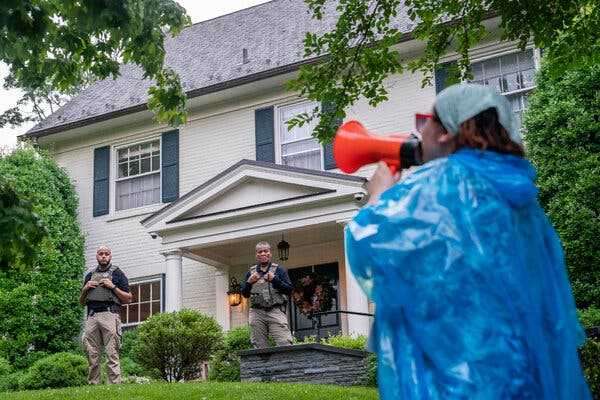One official criticized the request, saying that the federal government was primarily responsible for ensuring the safety of justices and their families.
-
Send any friend a story
As a subscriber, you have “>10 gift articles to give each month. Anyone can read what you share.
Give this article
- Read in app

Protests at the homes of Supreme Court justices, such as this one at Chief Justice John G. Roberts Jr.’s house in June, have become common after a leaked draft opinion overturning Roe v. Wade.
WASHINGTON — The chief security officer of the Supreme Court has asked that Virginia and Maryland officials enforce laws that would prohibit protests outside the homes of justices after weeks of demonstrations favoring abortion rights.
In four letters sent to Gov. Larry Hogan of Maryland; Gov. Glenn Youngkin of Virginia; Jeffrey McKay, the chairman of the Fairfax County Board of Supervisors; and Marc Elrich, the Montgomery County executive, the Supreme Court marshal, Gail A. Curley, cited protests and “threatening activity” in her request.
After a leaked draft opinion in early May showed that the court’s conservative majority was poised to overturn Roe v. Wade, which guaranteed a constitutional right to an abortion, protesters regularly gathered outside the homes of those justices to denounce the decision. The court formally issued its opinion in late June.
“Protesters gathered outside one Justice’s Fairfax County home chanting expletives,” read the letter to Mr. Youngkin, which was sent on Saturday. “And dozens appeared outside another’s Fairfax County home chanting ‘no privacy for us, no peace for you!’ This is exactly this kind of conduct that Virginia law prohibits.”
The laws cited by Ms. Curley are both state and local ordinances that would prohibit various kinds of demonstrations outside of private residences with certain exceptions, but it is unclear whether protesters have necessarily violated the laws.
From Opinion: The End of Roe v. Wade
Commentary by Times Opinion writers and columnists on the Supreme Court’s decision to end the constitutional right to abortion.
- Michelle Goldberg: “The end of Roe v. Wade was foreseen, but in wide swaths of the country, it has still created wrenching and potentially tragic uncertainties.”
- Spencer Bokat-Lindell: “What exactly does it mean for the Supreme Court to experience a crisis of legitimacy, and is it really in one?”
- Bonnie Kristian, journalist: “For many backers of former President Donald Trump, Friday’s Supreme Court decision was a long-awaited vindication.” It might also mark the end of his political career.
- Erika Bachiochi, legal scholar: “It is precisely the unborn child’s state of existential dependence upon its mother, not its autonomy, that makes it especially entitled to care, nurture and legal protection.”
In one of her letters, Ms. Curley also referred to the arrest last month of a California man who was found with a pistol and other weapons near the Chevy Chase, Md., home of Justice Brett M. Kavanaugh. Federal officials said the man planned to break into the justice’s home to kill him and have charged him with attempted murder.
On the evening of June 24, after the Supreme Court ended nearly 50 years of abortion rights, a small crowd chanted, sang and banged pots and pans on the quiet street in Burke, Va., where Justice Clarence Thomas lives. The police barricaded the entire block. Protesters also appeared outside the home of Justice Kavanaugh, seemingly outnumbered by police officers, and security vans were seen guarding the house of Justice Samuel A. Alito Jr. in Alexandria, Va.
The protests prompted by the leaked draft opinion intensified concerns about the safety of the justices, and a fence was erected around the Supreme Court building in response to demonstrations.
Last month, the House quickly passed a bill that would extend police protection to the immediate families of Supreme Court justices. The Senate has already passed the legislation, and it awaits President Biden’s signature.
All six of the Republican-appointed justices live in wealthy enclaves in Fairfax County, Va., and Montgomery County, Md., which border Washington.
Mr. Elrich, the Fairfax County official, said in a statement that he did not have any record of a letter from Ms. Curley, but he criticized her request, saying that the federal government was primarily responsible for ensuring the safety of justices and their families.
“It is very troubling that the court would take this approach,” Mr. Elrich said. “If the marshal is concerned about security, then she and her staff should communicate directly with our police chief, myself, and my staff rather than having a letter released to the press.”
In a statement, the Fairfax County Police Department said it was responsible for protecting the public, including three justices, and safeguarding the constitutional right of people to protest. It was “well versed” on the laws that govern protests, it said, adding that it had a unit specifically “trained to help crowds that gather to express their views.”
Both Mr. Youngkin and Mr. Hogan have previously expressed concern about the protests.
In statement posted to Twitter on Saturday, the communications director for Mr. Hogan said “the governor has directed Maryland State Police to further review enforcement options that respect the First Amendment and the Constitution.” He added that the Justice Department had declined a request from Mr. Hogan to enforce federal statutes prohibiting protesting at the justices’ residences.
Sadie Kuhns, an organizer with Our Rights DC, a group created by protesters in May that has organized more than 30 protests outside the homes of the conservative justices, said the group has not seen a law enforcement response to its demonstrations and has no plans to stop.
“These six people have control over millions of people’s lives,” Ms. Kuhns said. “And if the only thing we can do is exercise our First Amendment rights outside of their homes peacefully, that’s what we’re going to do. It empowers people.”
Source: nytimes.com



